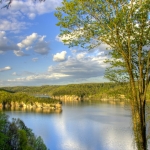
A man-made lake formed by the damming of the Gauley River, Summersville Lake has been called the cleanest, clearest freshwater lake east of the Mississippi. It is also the largest lake in West Virginia and one of its premier climbing destinations. It's primarily a sport climbing destination with routes ranging from vertical to severely overhanging. The lake itself provides a great way to cool off during summer months, and opportunities for deep water soloing exist, although it should be noted that cliff jumping has been outlawed and is punishable by a hefty fine.
Summersville features more than 350 routes on world class Nuttall Sandstone, which is found in the nearby New River Gorge and along the Meadow River . Against the backdrop of a clean, clear, deep blue lake, climbers find high quality sport climbs that range from 5.7 to 5.14 in difficulty and ascend 30 to 100 feet. Many popular areas at Summersville with moderate climbs can be very busy during the summer and especially on weekends.
The characteristically steep rock here features pockets, huecos, slopers, and jugs, as well as excellent edges and horizontals. Much of the rock is south-facing, which makes Summersville a good place to climb during colder weather, and, in fact, some areas are only accessible to climbers during colder months when water on the lake is low.
Summersville Lake was created between 1960 and 1966 to control flooding along the Gauley River and in the Kanawha Valley. An earthen dam made of 12 million cubic yards of rock and earth holds the Gauley River back to form a 3,000-acre lake with more than 60 miles of shoreline. Lucky for climbers, the river cuts through the impeccable Nuttall sandstone, and much of the rim of the lake is sheer rock with high quality climbing.
During summer months the lake waters are at their highest, and only part of the established climbing is accessible. During ‘Gauley Season,’ in the fall, whitewater rafters from across the the U.S. arrive to paddle the raging Gauley River, which is fed by scheduled volumes released out of the lake. This is good news for climbers who will have access to all of the potential climbing at Summersville Lake after sufficient water has been drained.
The main climbing area is situated on the northern side of the lake upstream and to the east of the U.S. 19 bridge that spans Summersville Lake. A climber’s trail is accessible from the parking area just north of the bridge. With the exception of Pirates Cove, climbing in this area is accessible year round regardless of the lake level. Some of the best sport climbs in the region are found here, and the excellent position next to the lake is unique. Add to that the opportunity to cool-off by swimming in the lake, and it’s no wonder this is such a popular area. In the fall, winter, and spring, low water areas like Whippoorwill, Pirates Cove, The Rat’s Hole, and Longpoint become fully accessible. Due to the seasonal nature of access to certain areas, many first ascents are still being found here.
Climbers at Summersville should be prepared to encountered hazards similar to those that might meet at other nearby climbing areas -- venomous snakes, stinging insects, high summer temperatures and humidity, and sun exposure. It is advised to avoid leaving valuables in plain view in vehicles at any of the climber parking areas. Climbers sometimes encounter bolts with missing hangers, unfortunately due to boaters who steal them for souvenirs when the water is up. Additional risk is assumed when swimming or climbing ropeless over water.
Read also: Summersville Lake Climbing Area
Author David Wolff is a certified climbing instructor and climbing guide at the New River Climbing School in southern West Virginia






























